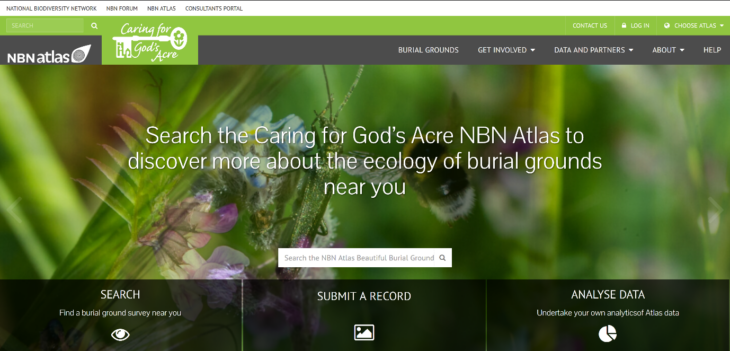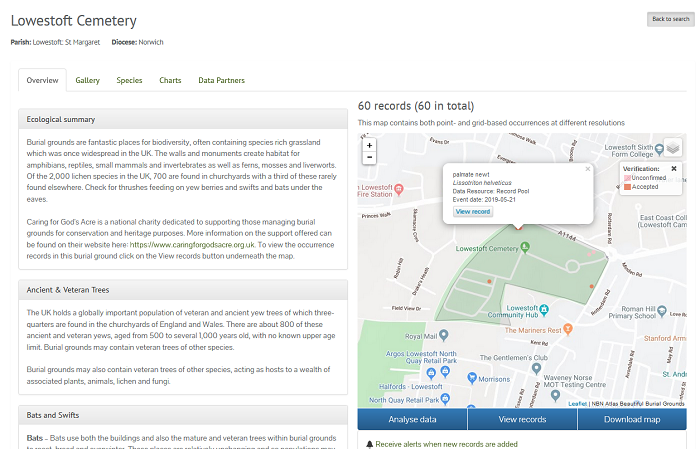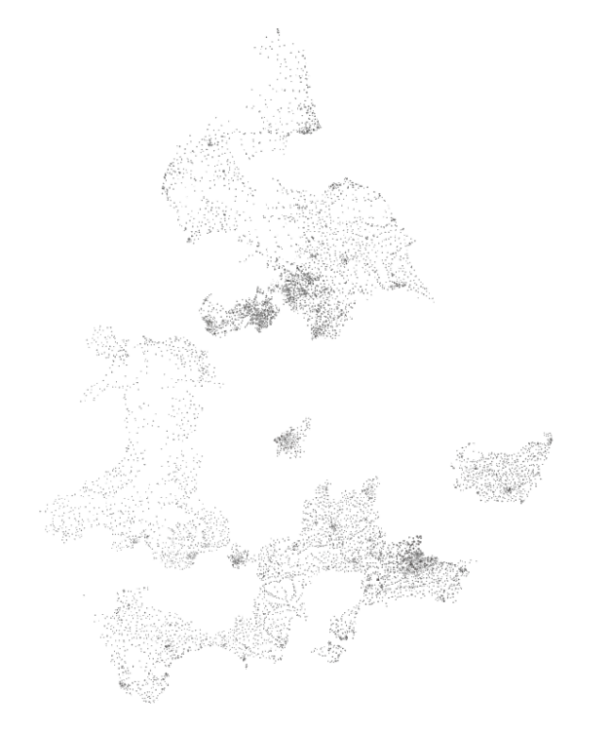
Written by Liam Taylor, The Beautiful Burial Ground Project
Burial grounds can be poorly understood in terms of their biodiversity when compared to other public green spaces. Many people feel that they need permission to search for and record wildlife within burial grounds and as a result, they are unaware of the interest of these sites.
Until now there has been no national database of biological records in burial grounds. Anyone interested in burial grounds has had to contact both individuals and groups to find the information they wanted; and in many cases, the information cannot be found, even by a dedicated searcher!
Thanks to the National Lottery Heritage Fund and the hard work of the team at the NBN Atlas, we are glad to share the launch of a new system which makes it easy for anyone to learn more about the wildlife found at different burial grounds across England and Wales.
Over the past few years we have been designing and creating our burial ground portal with the NBN Atlas team. The Burial Grounds Portal is part of the much larger NBN Atlas, and it focuses solely on records known to be from within burial grounds.
Why is this important?
- Accessibility. We have provided a highly accessible way for the public, church wardens and other site managers, naturalists and researchers, to discover the types of wildlife that have been recorded at burial grounds.
- Coverage. Burial Grounds are under-recorded, we rely on records to highlight sites with significant ecological value. Without records, it might be that a handful of individuals are aware that a site is special, but this knowledge could easily be lost over time.
- Protection. Organisations such as the Church of England, Church in Wales, and local authorities need easy access to data on the ecology of their churchyards to help with planning, protection, designation and interpretation.
- Targeted recording. We have made it possible for wildlife recorders to find burial grounds in their areas, learn whether there is anything currently known about an individual site, and plan where to go to enjoy looking for wildlife and making records.
- Open-access. All of the records and information on the portal is completely open to anyone who has access to a computer, a phenomenal resource for individuals and groups approaching the subject for a variety of reasons.
- Attitudes. Historically the profile of burial grounds as places to observe and encourage wildlife has been low within the wildlife recording community. The Beautiful Burial Ground project, this portal and the activities we are running, are helping to raise the profile and encourage more people to get involved with the conservation of burial grounds.
- Built Heritage. Whilst the portal is primarily dedicated to ecology, we will be letting people know about built and social heritage as well, and the next stage will be to link the portal with both the Church Heritage Record and Church Heritage Cymru.
- Management. Accessible records help those managing these special places to make informed decisions. A good site management plan depends on the knowledge of species present.
- Designation. Many burial grounds deserve recognition for their exceptional ecological value and may warrant the protection of a designation such as Local Wildlife Site. For this to happen, records of wildlife are crucial.
Who benefits?
We hope that many people will find the portal interesting and will start to use it regularly. It will be of great interest to:
- Communities learning about their locality
- Biological Recorders
- Built/social heritage enthusiasts
- Local authorities managing municipal cemeteries and closed churchyards
- The Church of England and Church in Wales
- Churchwardens and Parochial Church Councils

Coverage

So far, we have added half of the English dioceses and all the Welsh dioceses to the portal. We are hoping to add the remaining English dioceses as soon as we receive the information needed from the Church of England.
Of the 10,389 sites we have listed so far, only 2,318 of those have records at the moment. Please see if you can add some records to the portal, we want to know about all species seen, from common species to rarities. Help us to fill in the gaps!
We are working with a wide range of partners to increase the biological records on the portal, more information is going up every week. Please keep checking sites that you are interested in to see if something exciting has been added.
If you are interested in recording in burial grounds near you, just get in touch; we can provide you with a list of a few sites near to where you are.
The following dioceses are currently available on the portal:
- Bangor
- Birmingham
- Bristol
- Carlisle
- Exeter
- Guildford
- Lincoln
- Liverpool
- Llandaff
- London
- Manchester
- Monmouth
- Norwich
- Newcastle
- Oxford
- Portsmouth
- Rochester
- Salisbury
- Sheffield
- Southwark
- St David
- St Edmundsbury
- Swansea and Brecon
- York
Moving Forward
The Burial Grounds Portal can be reached via an internet search, just look for ‘burial grounds portal nbn’. Alternatively you can visit the website directly – burialgrounds.nbnatlas.org. We welcome your feedback.

We believe the creation of the Burial Grounds Portal is a significant achievement, one we are proud to launch in 2020. This launch is an important step in realising our goal of encouraging people to investigate,?care for and enjoy the interesting wildlife and heritage to be found within burial grounds.
Acknowledgements
With thanks to The National Lottery Heritage Fund, National Biodiversity Network Trust, Church in Wales, Church of England and the many people sending in records.
